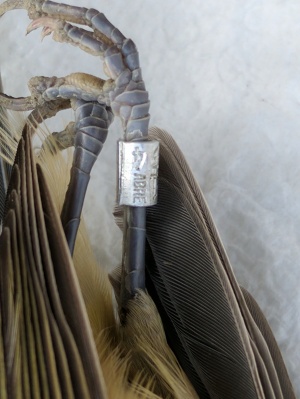
On September 3, 2017, SIB received an email from Richard Sidebottom.
“We live in Charleston and are out here often. My in-laws (the kids grandparents) are Jerry and Jenny Reves, who have had a house here since 1995. Jerry is the former Dean at MUSC and writes the wellness column in The Seabrooker.
We arrived out here from town yesterday and the kids saw a dead yellow and black/gray bird on the deck and also noticed the identification band around its leg. My kids enjoy looking at the nature guides (including Audubon / Peterson’s Field Guide) that their grandparents have at the house, so we tried to identify it. We think it may be a female Painted Bunting. It occurred to me this morning as we were trying to figure out how to bury it that we should ask whether someone should know about the band. The band says: OPEN 2721 ABRE, 24834
Thanks,
Richard Sidebottom
The two photos below were attached:
Nancy Brown, the SIB Communications Chair, corresponded with Richard and provided the USGS link to report banded birds so he could officially report the condition of the bird.
https://www.pwrc.usgs.gov/bbl/bblretrv/index.cfm
Nancy also sent a note to Aaron Given, Wildlife Biologist on Kiawah Island, who manages a bird banding station on Kiawah. As she suspected, Aaron responded: “We banded it on 8/26/17 at the Captain Sam’s site on the west end of Kiawah. This is a hatch-year bird because of the buffy edging on the wing coverts therefore the sex is unknown. The most likely cause of death was by window strike.”
When you report a banded bird to the USGS, you will receive a certificate of appreciation, similar to the one below sent to the Sidebottom family.

If you missed any of SIB’s other blogs about banded birds, you can find them by searching on the “Banding” category, or click on this link.
Read the article below to learn more about finding birds with leg bands:
When a dead, wild bird is found that has a leg ring attached, it’s crucial for the individual who found the bird to go about the correct steps in getting the information to the right people. Participating in this process is a way to continue the help given to these migratory birds as well as continue with the efforts by those involved for researching and developing strategies to help these North American migratory birds to thrive.
The first step in this process is to determine the type of bird and leg ring that you have come upon in order to follow the appropriate steps. Metal bands are used for terrestrial birds, which are birds that inhabit land rather than air or water. These metal bands should be reported to the Bird Banding Laboratory by simply going on to their website and clicking on the “Report a Bird Band or a Marked Bird” link. The link will allow you to follow a few simple questions in reporting the band. There should be a phone number on the band to bypass the website but many people use the website to obtain a Certificate of Appreciation to acknowledge their participation in helping with the services provided by the U.S. Geological Survey Patuxent Wildlife Research Center.
Plastic leg rings and collars are found on water birds and shorebirds. Although there is a color-coded system for plastic bands from researchers in Central and South America, the international banding program can still be implemented for those finding these types of dead, wild birds through the website for the Bird Banding Laboratory. The process is the same in reporting the bird and the finder will receive information on where the bird was originally tagged along with the date and species of the bird.
However, for bands with the letters AU, IF, CU, NPA, or IPB; there is a separate agency that handles the bands. The database for these birds strictly belong within the research related to pigeons and the American Racing Pigeon Union website will redirect people where there are individual links to report these dead, wild birds. The first two series on the band will dictate the individual database, the second series is the year the bird was tagged, the third in the series is the club code and the last set is the actual serial number given to the individual bird. Reading the band correctly is crucial in contacting the correct organization to report the dead, wild bird.
When finding a dead, wild bird with a band, collar or leg ring; it’s important to follow the correct steps in helping to report the incident. The banding of these migratory birds is important to helping not only their longevity but also learning more about habits that can affect everything from environmental contaminants to hazards around airports and airplanes. It’s important to do your part in terms of nature conservation and research to create a better and safer environment for yourself and future generations.
Source: http://www.second-opinion-doc.com/what-to-do-if-a-dead-wild-bird-is-found-that-has-a-leg-ring.html
Submitted by: Nancy Brown




